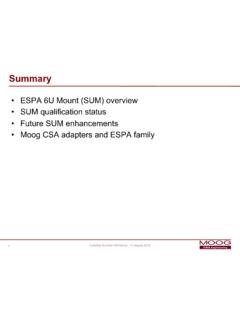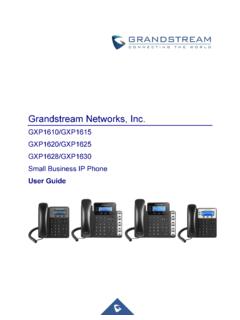Transcription of Spaceflight, Inc. General Payload Users Guide
1 spaceflight , Inc. Payload Users Guide SF 2100 PUG 00001 Rev F 2015 22 15 i spaceflight , Inc. General Payload Users Guide 3415 S. 116th St, Suite 123 Tukwila, WA 98168 spaceflight , Inc. Payload Users Guide SF 2100 PUG 00001 Rev F 2015 22 15 ii Document Revision History Rev Approval Date Changes ECN No. Sections / Pages Approved CM A 2011 09 16 Initial Release B 2012 03 30 Updated electrical interfaces and launch environments C 2012 07 18 Official release D 2013 03 05 Updated electrical interfaces and launch environments, reformatted, and added to sections E 2014 04 15 Updated organization and formatting, added content on SHERPA, Mini SHERPA and ISS launches, updated RPA CG F 2015 05 22 Overall update spaceflight , Inc. Payload Users Guide SF 2100 PUG 00001 Rev F 2015 22 15 iii Table of Contents 1 Introduction .. 7 Document Overview .. 7 spaceflight Overview.
2 7 Hardware Overview .. 9 Mission Management Overview .. 10 2 Secondary Payload Integration and Hosting Products .. 12 SHERPA .. 13 SHERPA 400/1000/2200 .. 13 MiniSHERPA .. 15 3 Secondary Payload Interface Adapters .. 16 Directly Mounted Payload to ESPA Ring Port Interface Adapter .. 17 RPA Mounting Interface Definition .. 20 DPA Mounting Interface .. 25 4 CubeSat Requirements and Dispensers .. 27 General CubeSat Requirements .. 27 ISIS ISIPOD Dispensers .. 28 Planetary Systems Corp. Canisterized Satellite Dispenser .. 29 CubeSat deployment from the International Space Station .. 30 5 Secondary Payload Separation Devices .. 32 Mark II Motorized Lightband .. 32 6 Analyses Coordinated with LSP .. 34 Trajectory Analysis .. 34 Coupled Loads Analysis .. 34 RF Compatibility Analysis .. 34 Thermal Analysis .. 35 Separation Timing and Re contact Analysis .. 35 Range Safety Analysis.
3 35 spaceflight , Inc. Payload Users Guide SF 2100 PUG 00001 Rev F 2015 22 15 iv Post flight Data Analysis .. 35 Documentation .. 35 7 Analysis of Adherence to Other Requirements .. 38 Common Environments .. 38 Payload Design and Construction Constraints .. 43 Payload Safety and Hazards .. 44 Electrical and Data Interfaces .. 45 8 Final Integration and Launch Operations .. 46 Payload Transportation .. 46 Secondary Payload provider Involvement during Integration .. 46 Integration and Handoff .. 46 Appendix A: Acronyms and Abbreviations .. 48 Appendix B Secondary Payload Questionnaire Template .. 49 spaceflight , Inc. Payload Users Guide SF 2100 PUG 00001 Rev F 2015 22 15 v List of Figures Figure 1 1 spaceflight is responsible for the interface between all secondary payloads .. 8 Figure 2 1 SHERPA with Adapters .. 12 Figure 2 2 Delta V Capabilities .. 14 Figure 2 3 Propulsive SHERPA Capabilities.
4 15 Figure 2 4 MiniSHERPA Delta V Capabilities .. 16 Figure 3 1 SHERPA with Interface Adapters .. 17 Figure 3 2 Directly Mounted Payload Exploded View .. 18 Figure 3 3 Bolt Hole Pattern for Directly Mounted Payload .. 19 Figure 3 4 Volume Constraints ( fairing baselined) .. 20 Figure 3 5 Radial Payload Adapter Secondary Payload Coordinate System .. 21 Figure 3 6 Bolt hole pattern for radial port adapter .. 22 Figure 3 7 Volume Constraints ( fairing baselined) .. 23 Figure 3 8 VPA mechanical interface with dimensions in inches [mm] .. 24 Figure 3 9 Allowable Static Payload Envelope within the Deployable Shroud with dimensions in inches [mm] .. 25 Figure 3 10 DPA System .. 25 Figure 0 1 ISIPOD 3U CubeSat Dispenser .. 29 Figure 0 2 NanoRacks CubeSat Deployer .. 30 Figure 0 3 NanoRacks Electrical Inhibit Diagram .. 31 Figure 5 1 Mark II Motorized Lightband Manufactured by Planetary Systems Corporation (8 inch).
5 32 Figure 7 1 Maximum Predicted Acoustic Environment .. 39 Figure 7 2 Secondary Payload Generalized Random Vibration Environment .. 40 Figure 7 3 Maximum Predicted Electromagnetic Environment during Pad Operations and Launch .. 41 Figure 7 4 Maximum Payload Fairing (PLF) Temperature Seen by the Payload .. 42 Figure 7 5 Narrowband Radiated E field Limits .. 44 Figure 7 6 Broadband Radiation Limits .. 44 spaceflight , Inc. Payload Users Guide SF 2100 PUG 00001 Rev F 2015 22 15 vi List of Tables Table 1 1 Standard Mission Integration Process .. 10 Table 2 1 Propulsive SHERPA Technical Details .. 13 Table 2 2 MiniSHERPA Capabilities .. 15 Table 3 1 Allowable Spacecraft Wet Mass per Interface Adapter .. 17 Table 3 2 Directly Mounted Payload Mass Properties .. 18 Table 3 3 Radially Mounted Payload Mass Properties .. 21 Table 3 4 Vertically Mounted Payload Mass Properties .. 23 Table 3 5 Vertically Mounted Payload Mass Properties.
6 26 Table 5 1 Mark II Lightband Options .. 32 Table 6 1 Required Mission Specific Deliverables .. 37 Table 7 1 Maximum Predicted Acoustic Environment .. 39 Table 7 2 Secondary Payload Generalized Random Vibration Environment .. 40 Table 7 3 Maximum Predicted Electromagnetic Environment during Pad Operations and Launch .. 41 Table 7 4 Payload environments during ground processing .. 42 Table 7 5 Maximum PLF Temperature seen by the Payload .. 42 spaceflight , Inc. Payload Users Guide SF 2100 PUG 00001 Rev F 2015 05 22 7 1 Introduction Document Overview This spaceflight Payload Users Guide (SPUG) is published by spaceflight , Inc. to provide General information to Payload developers whom will launch their Payload or spacecraft using spaceflight s integration services. It includes descriptions on the various flight support hardware, interfaces, capabilities, launch environments, policies and top level processes spaceflight uses to manifest your Payload and deliver you to your mission orbit.
7 Further information may be obtained by contacting spaceflight directly through spaceflight Overview spaceflight , Inc. ( spaceflight ) provides launch services through various mission concepts that provide shared launch capability to multiple spacecraft. spaceflight accomplishes this through several methods and provides varying levels of mission integration support to our customers. spaceflight serves as the integrating entity across our platform of mission concepts where spaceflight contracts directly with multiple payloads and the Launch Service Providers (LSP). spaceflight has successfully opened an entirely new market to those payloads that cannot afford the cost of a dedicated launch. One of the biggest challenges of the past has been getting the LSPs to support the management of many disparate programs integrating on a single launch. spaceflight has broken down this barrier by presenting a single point of contact to the LSPs representing an integrated Payload stack that consists of 1 or more (at the date of this SPUG revision spaceflight has developed an integrated Payload stack that has free flying payloads) Payload .
8 This concept has proven so successful that spaceflight now has agreements in place and/or weekly discussions with all the major launch providers, ensuring that there is a launch to match your mission requirements. spaceflight takes on the financial risk of the launch opportunities by procuring the excess capacity on dedicated launches of a primary Payload or through procuring the entire launch capability ourselves and selling the launch opportunities to multiple customers. In either of these two scenarios we are able to provide access to space that is a true enabler for the emerging small satellite constellations, one off demonstrations, Government science and operational objectives and the booming business sparked by the CubeSat community. To offer the best costs to our customers we have designed our support hardware to the common standards, yet our innovative staff of engineers and qualified vendors allow spaceflight to accommodate the one off designs as well as keep pace with the changing technologies.
9 spaceflight is also unique in that our service costs are posted on line at While committing to advertised firm fixed prices in the aerospace world has always been a challenge, spaceflight s approach, laid out in this document, allows us to confidently and routinely provide our launch services to the what may be termed as the disadvantaged satellite community. When the business started we frequently labeled our customer base as secondary and small satellites. That has spaceflight , Inc. Payload Users Guide SF 2100 PUG 00001 Rev F 2015 05 22 8 changed and we are now supporting payloads that range from 1U CubeSats to Geo stationary satellites that mass upwards of 2,000kgs. This has allowed us to also expand our services from providing secondary services on an LSP s primary mission to spaceflight procuring the entire launch capability. In fact, starting in 2017 and every year thereafter, spaceflight will be procuring a Sun Synchronous launch dedicated to providing our customers consistent and reliable access to space.
10 A secondary Payload provider can purchase Payload launch services from spaceflight , who then coordinates and arranges for integration and launch. spaceflight , supported by the secondary Payload providers, is responsible for analyses and physical integration of multiple payloads into a package that is treated as a discrete Payload . This organizational structure is shown in Figure 1 1. Figure 1 1 spaceflight is responsible for the interface between all secondary payloads Benefits for Satellite Developers Fully arranged launch, from contract to orbital insertion Experienced Payload integrators with existing dispensers and interfaces Experienced licensing and export control assistance Benefits for LSP Broad access to the small satellite market Experienced party as representative of ALL secondary payloads Standardized interface control, documentation and test reports spaceflight provides a single one stop shop for integrating a wide range of suborbital and orbital payloads and providing them with responsive space access.









